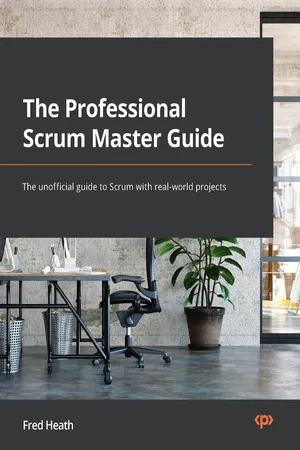
The Professional Scrum Master Guide
Fred Heath
- 174 pages
- English
- ePUB (mobile friendly)
- Available on iOS & Android
The Professional Scrum Master Guide
Fred Heath
About This Book
Go from absolute beginner to passing your exam the first time with this comprehensive guide. Filled with real-world illustrations, this book has been revised to align with the most recent Scrum standards, empowering you to become a Scrum Expert!
Key Features
- Go from absolute beginner to exam-ready with detailed explorations of Scrum use-cases
- Understand the different applications of agile concepts, and how to best apply them to your business
- Discover expert tips and work with real-world examples to pass the certification exam the first time
Book Description
This book demonstrates the real-world applications of Scrum in a variety of scenarios, all with practical examples. You'll understand why the structure of your Scrum team matters, and how to create and manage sprint and product backlogs. Each chapter concludes with relevance to the exam, reinforcing what you've learned as you work through the book and making sure you have an edge when it comes to earning your certificate.The statements made and opinions expressed herein belong exclusively to Packt Publishing Ltd and are not shared by or represent the viewpoint of Scrum.org. This training does not constitute an endorsement of any product, service or point of view. Scrum.org makes no representations, warranties or assurances of any kind, express or implied, as to the completeness, accuracy, reliability, suitability, availability or currency of the content contained in this presentation or any material related to this presentation. In no event shall Scrum.org, its agents, officers, employees, licensees or affiliates be liable for any damages whatsoever (including, without limitation, damages for loss of profits, business information, or loss of information) arising out of the information or statements contained in the training. Any reliance you place on such content is strictly at your own risk.
What you will learn
- Get to grips with Agile development and Scrum from the ground up
- Understand the roles and responsibilities within the Scrum team
- Discover how to conduct Scrum events and create Scrum artifacts
- Explore real-world scenarios and use cases for Scrum in action
- Develop an in-depth understanding of how to run a successful sprint to deliver results quickly
- Be fully prepared and able to pass your exam the first time
Who this book is for
Assuming no prior knowledge of Scrum, this book is for professionals who want to build a strong foundation in Scrum practices with the intention of passing the certification exam. If you're a product owner or project manager looking to stay relevant in an agile world, this book is essential to helping you become a Scrum expert.
]]>
Frequently asked questions
Information
Section 1: The Scrum Framework
- Chapter 1, Introduction to Scrum
- Chapter 2, Scrum Theory and Principles
- Chapter 3, The Scrum Team
- Chapter 4, Scrum Events
- Chapter 5, Scrum Artifacts
Chapter 1: Introduction to Scrum
- What is Agile software development?
- What is Scrum?
- The value of an iterative and incremental approach
- Why should you choose Scrum?
- Introducing PSM I assessment
What is Agile software development?
- Individuals and interactions over processes and tools
- Working software over comprehensive documentation
- Customer collaboration over contract negotiation
- Responding to change over following a plan
- Our highest priority is to satisfy the customer through early and continuous delivery of valuable software.
- Welcome changing requirements, even late in development. Agile processes harness change for the customer's competitive advantage.
- Deliver working software frequently, from every couple of weeks to every couple of months, with a preference for a shorter timescale.
- Businesspeople and developers must work together daily throughout the project.
- Build projects around motivated individuals.
- Give them the environment and support they need and trust them to get the job done.
- The most efficient and effective method of conveying information to and within a development team is face-to-face conversation.
- Working software is the primary measure of progress.
- Agile processes promote sustainable development.
- The sponsors, developers, and users should be able to maintain a constant pace indefinitely.
- Continuous attention to technical excellence and good design enhances agility.
- Simplicity – the art of maximizing the amount of work not done – is essential.
- The best architectures, requirements, and designs emerge from self-organizing teams.
- At regular intervals, the team reflects on how to become more effective, then tunes and adjusts its behavior accordingly.
What is Scrum?
- The Scrum Team: A self-organizing, cross-functional set of people who will deliver the working software.
- Scrum Events: A number of time-boxed events that help create regularity, provide feedback, foster self-adjustment, and promote an iterative and incremental lifecycle.
- Scrum Artifacts: Items that represent work or added value and that provide transparency for the team's work progress and achievements. Artifacts are also the corne...
Table of contents
- The Professional Scrum Master (PSM I) Guide
- Contributors
- Preface
- Section 1: The Scrum Framework
- Chapter 1: Introduction to Scrum
- Chapter 2: Scrum Theory and Principles
- Chapter 3: The Scrum Team
- Chapter 4: Scrum Events
- Chapter 5: Scrum Artifacts
- Section 2: Scrum in Action
- Chapter 6: Planning and Estimating with Scrum
- Chapter 7: The Sprint Journey
- Chapter 8: Facets of Scrum
- Section 3: The PSM Certification
- Chapter 9: Preparing for the PSM I Assessment
- Assessments
- Other Books You May Enjoy